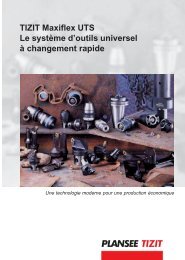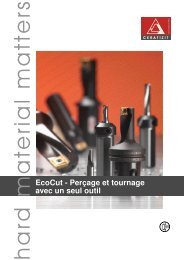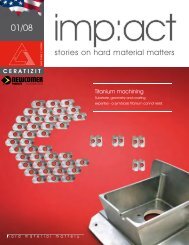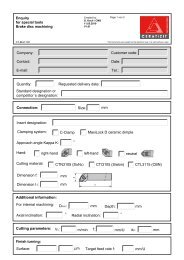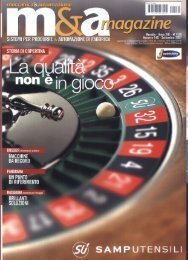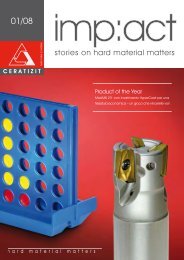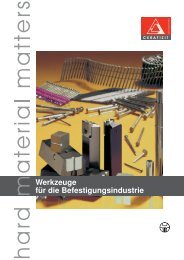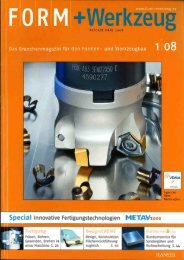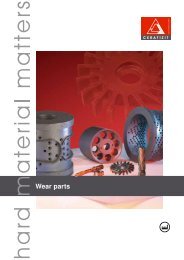stories on hard material matters - Ceratizit S.A.
stories on hard material matters - Ceratizit S.A.
stories on hard material matters - Ceratizit S.A.
Create successful ePaper yourself
Turn your PDF publications into a flip-book with our unique Google optimized e-Paper software.
Due to the saline air and the str<strong>on</strong>g gale-force winds in<br />
H<strong>on</strong>g K<strong>on</strong>g the upper 120 metres of the 300 metres high<br />
bridge pyl<strong>on</strong>s were cladded with high-tensile stainless<br />
steel (duplex) by Outokumpu. The company produced<br />
both the cladding elements made of stainless steel (all<br />
in all 2,000 t<strong>on</strong>s) and the anchoring of the main bearer<br />
cables. What is so special about it? The duplex stainless<br />
steel will need no maintenance work for the entire<br />
service life of the bridge.<br />
More than <strong>on</strong>ly stainless steel sheets<br />
Outokumpu however does not <strong>on</strong>ly supply stainless steel<br />
sheets. The company supports customers with regard to<br />
<strong>material</strong> selecti<strong>on</strong>, planning and c<strong>on</strong>structi<strong>on</strong> during the<br />
entire project and optimally prepares the sheet metal<br />
with perfect surface treatment, precise form and joints<br />
tailored to the welders’ needs.<br />
High demands with regard to the CERATIZIT inserts<br />
The CERATIZIT cutting inserts are used at Outokumpu<br />
for the preparati<strong>on</strong> of joints. With the HyperCoat grade<br />
CTP2235 Outokumpu mills the most varied joint profiles.<br />
Stainless steel is a <strong>material</strong> which is difficult to machine.<br />
Internal cladding in stainless steel in a tanker that transports chemical <strong>material</strong>s.<br />
SHIP BUILDING TRILOGY 3/3 - OUTOKUMPU<br />
For example, its thermal c<strong>on</strong>ductivity is <strong>on</strong>ly a third of the<br />
thermal c<strong>on</strong>ductivity of machining steel. For this reas<strong>on</strong><br />
the heat that is produced during machining can <strong>on</strong>ly be<br />
evacuated insufficiently through the swarf. The tendency<br />
towards work <strong>hard</strong>ening is relatively high. This means<br />
that after a first machining step the <strong>material</strong> <strong>on</strong> the<br />
surface becomes <strong>hard</strong>er than before, so the cutting edge<br />
needs to perform even better in the sec<strong>on</strong>d operati<strong>on</strong>.<br />
Furthermore, stainless steel is particularly tough, has a<br />
relatively high tendency to adhesi<strong>on</strong> and bad chip<br />
formati<strong>on</strong>. This is why its machinability is four times<br />
worse than the <strong>on</strong>e of machining steel. Especially for<br />
Outokumpu CERATIZIT has developed the cutting<br />
insert SEAN250161 and offers a tailored soluti<strong>on</strong> for the<br />
machining of stainless steel. The inserts are used in a strip<br />
edge milling cutter by Outokumpu. In this way the ideal<br />
tool is created for the machining of difficult <strong>material</strong>s<br />
such as stainless steel. Good clamping, small tool overhang<br />
and small corner radius or radius of the cutting<br />
edge are decisive to avoid vibrati<strong>on</strong> and cutting forces.<br />
Sufficient cutting depth should be applied so that the<br />
cutting edges in the following operati<strong>on</strong> interact as little as<br />
possible with the cold formed layer.<br />
13



